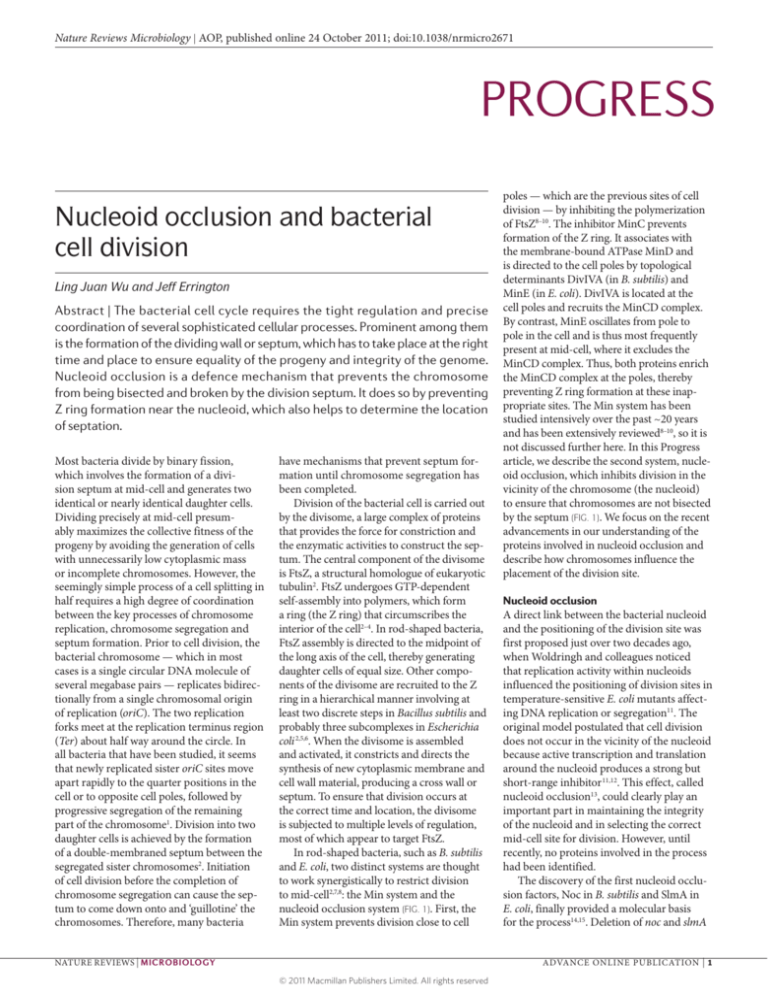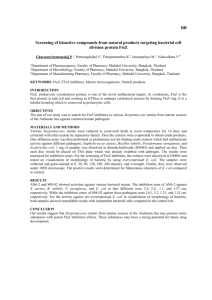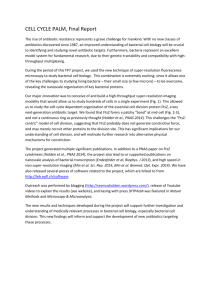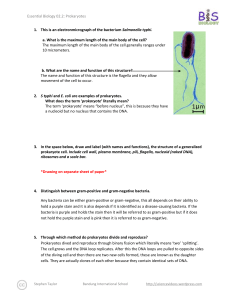
Nature Reviews Microbiology | AOP, published online 24 October 2011; doi:10.1038/nrmicro2671
PROGRESS
Nucleoid occlusion and bacterial
cell division
Ling Juan Wu and Jeff Errington
Abstract | The bacterial cell cycle requires the tight regulation and precise
coordination of several sophisticated cellular processes. Prominent among them
is the formation of the dividing wall or septum, which has to take place at the right
time and place to ensure equality of the progeny and integrity of the genome.
Nucleoid occlusion is a defence mechanism that prevents the chromosome
from being bisected and broken by the division septum. It does so by preventing
Z ring formation near the nucleoid, which also helps to determine the location
of septation.
Most bacteria divide by binary fission,
which involves the formation of a division septum at mid-cell and generates two
identical or nearly identical daughter cells.
Dividing precisely at mid-cell presumably maximizes the collective fitness of the
progeny by avoiding the generation of cells
with unnecessarily low cytoplasmic mass
or incomplete chromosomes. However, the
seemingly simple process of a cell splitting in
half requires a high degree of coordination
between the key processes of chromosome
replication, chromosome segregation and
septum formation. Prior to cell division, the
bacterial chromosome — which in most
cases is a single circular DNA molecule of
several megabase pairs — replicates bidirectionally from a single chromosomal origin
of replication (oriC). The two replication
forks meet at the replication terminus region
(Ter) about half way around the circle. In
all bacteria that have been studied, it seems
that newly replicated sister oriC sites move
apart rapidly to the quarter positions in the
cell or to opposite cell poles, followed by
progressive segregation of the remaining
part of the chromosome1. Division into two
daughter cells is achieved by the formation
of a double-membraned septum between the
segregated sister chromosomes2. Initiation
of cell division before the completion of
chromosome segregation can cause the septum to come down onto and ‘guillotine’ the
chromosomes. Therefore, many bacteria
have mechanisms that prevent septum formation until chromosome segregation has
been completed.
Division of the bacterial cell is carried out
by the divisome, a large complex of proteins
that provides the force for constriction and
the enzymatic activities to construct the septum. The central component of the divisome
is FtsZ, a structural homologue of eukaryotic
tubulin2. FtsZ undergoes GTP-dependent
self-assembly into polymers, which form
a ring (the Z ring) that circumscribes the
interior of the cell2–4. In rod-shaped bacteria,
FtsZ assembly is directed to the midpoint of
the long axis of the cell, thereby generating
daughter cells of equal size. Other components of the divisome are recruited to the Z
ring in a hierarchical manner involving at
least two discrete steps in Bacillus subtilis and
probably three subcomplexes in Escherichia
coli 2,5,6. When the divisome is assembled
and activated, it constricts and directs the
synthesis of new cytoplasmic membrane and
cell wall material, producing a cross wall or
septum. To ensure that division occurs at
the correct time and location, the divisome
is subjected to multiple levels of regulation,
most of which appear to target FtsZ.
In rod-shaped bacteria, such as B. subtilis
and E. coli, two distinct systems are thought
to work synergistically to restrict division
to mid-cell2,7,8: the Min system and the
nucleoid occlusion system (FIG. 1). First, the
Min system prevents division close to cell
NATURE REVIEWS | MICROBIOLOGY
poles — which are the previous sites of cell
division — by inhibiting the polymerization
of FtsZ8–10. The inhibitor MinC prevents
formation of the Z ring. It associates with
the membrane-bound ATPase MinD and
is directed to the cell poles by topological
determinants DivIVA (in B. subtilis) and
MinE (in E. coli). DivIVA is located at the
cell poles and recruits the MinCD complex.
By contrast, MinE oscillates from pole to
pole in the cell and is thus most frequently
present at mid-cell, where it excludes the
MinCD complex. Thus, both proteins enrich
the MinCD complex at the poles, thereby
preventing Z ring formation at these inappropriate sites. The Min system has been
studied intensively over the past ~20 years
and has been extensively reviewed8–10, so it is
not discussed further here. In this Progress
article, we describe the second system, nucleoid occlusion, which inhibits division in the
vicinity of the chromosome (the nucleoid)
to ensure that chromosomes are not bisected
by the septum (FIG. 1). We focus on the recent
advancements in our understanding of the
proteins involved in nucleoid occlusion and
describe how chromosomes influence the
placement of the division site.
Nucleoid occlusion
A direct link between the bacterial nucleoid
and the positioning of the division site was
first proposed just over two decades ago,
when Woldringh and colleagues noticed
that replication activity within nucleoids
influenced the positioning of division sites in
temperature-sensitive E. coli mutants affecting DNA replication or segregation11. The
original model postulated that cell division
does not occur in the vicinity of the nucleoid
because active transcription and translation
around the nucleoid produces a strong but
short-range inhibitor 11,12. This effect, called
nucleoid occlusion13, could clearly play an
important part in maintaining the integrity
of the nucleoid and in selecting the correct
mid-cell site for division. However, until
recently, no proteins involved in the process
had been identified.
The discovery of the first nucleoid occlusion factors, Noc in B. subtilis and SlmA in
E. coli, finally provided a molecular basis
for the process14,15. Deletion of noc and slmA
ADVANCE ONLINE PUBLICATION | 1
© 2011 Macmillan Publishers Limited. All rights reserved
PROGRESS
allows the division septum to form over
unsegregated nucleoids under certain conditions, resulting in bisection of the chromosome, whereas overproduction of these
proteins leads to longer cells, as would be
expected for proteins that inhibit cell division14,15. Neither of the genes is essential in
their respective organisms: in both cases,
they were found through a synthetic-lethal
phenotype in cells with a defective Min system.
Unexpectedly, division in noc min and slmA
min double mutants was severely inhibited.
In principle, loss of the two systems might
be expected to result in uncontrolled division at any point along the length of the rod,
rather than an inhibition of division14,15. This
raised the possibility that these two negative
regulators are needed to sequester FtsZ to a
particular place in the cell (mid-cell) and that
in the absence of these systems FtsZ does not
reach a sufficiently high local concentration
to condense into a ring structure.
Interestingly, Noc and SlmA have no
sequence or structural similarity and associate
with the nucleoid through different DNAbinding domains that recognize specific DNA
sequences in the chromosomes. In addition,
there may be mechanistic differences in the
ways that the proteins inhibit the divisome.
Figure 1 | Temporal and spatial regulation of cell division by nucleoid occlusion and the Min
system in rod-shaped bacteria. a–d
a) and those that have not yet
b–d), nucleoid occlusion exerted by the nucleoid
prevents the assembly of FtsZ anywhere in the cell. According to a recently proposed model21, initia
b
oriC) also triggers the accu
in intensity as replisome assembly progresses. e
f
Ter)) and the sister chromosomes are segregated to quarter positions, the
remainder of the cell division machinery is assembled. For simplicity, the cell wall has been omitted.
2 | ADVANCE ONLINE PUBLICATION
SlmA affects FtsZ polymerization
The synthetic-lethal effect of the noc min
and slmA min double mutants in B. subtilis
and E. coli can be partially relieved by overproduction of FtsZ14,15, suggesting that these
two nucleoid occlusion factors act at the
level of FtsZ or a protein upstream in the
assembly of the divisome. Indeed, a direct
interaction between FtsZ and SlmA has been
detected in vitro15. Two groups have reported
biochemical and structural analyses of SlmA
and, although these groups drew different
conclusions, the studies provide valuable
information on the possible molecular mechanism by which SlmA inhibits cell division.
The first group showed that SlmA disassembles FtsZ polymers in vitro in a manner that
requires the GTPase activity of FtsZ and that
the activity of SlmA is stimulated on DNA
binding 16. This group also analysed two slmA
mutants with contrasting phenotypes (defective in either binding DNA or interacting
with FtsZ) in vivo and in vitro, and proposed
that SlmA acts as a dimer that prevents the
formation of the Z ring by breaking down the
FtsZ polymers16 (FIG. 2a,b).
By contrast, the second group found
that FtsZ polymer assembly is not prevented
by SlmA but that its higher-order assembly
is affected17. The crystal structure of
SlmA revealed structural similarity to the
www.nature.com/reviews/micro
© 2011 Macmillan Publishers Limited. All rights reserved
PROGRESS
tetracycline repressor (TetR) family of
regulators17, with two helices in the aminoterminal domain that form a helix–turn–
helix motif which is presumably involved
in DNA binding. The carboxy-terminal
domain contains several hydrophobic residues that form the dimer interface, but it
lacks the ligand-binding site that is present
in the C terminus of TetR family members,
consistent with its function in nucleoid
occlusion rather than transcription17.
Using small-angle X-ray-scattering
analyses, the second group showed that basic
residues in the C-terminal domain of each
subunit in the SlmA dimer most probably
interact with the multiple glutamate residues
in the C-terminal domain of FtsZ without
affecting the GTP-binding pocket of FtsZ17.
Consistent with this observation, they found
that the interaction between SlmA and FtsZ
does not require GTP. Consequently, each
SlmA-bound FtsZ molecule can polymerize
independently into a protofilament, but the
two FtsZ protofilaments sandwiching the
same SlmA dimer grow in opposite directions, forming higher-order spiral structures,
and therefore cannot assemble large, functional polymers17 (FIG. 2c).
So far, attempts to detect a direct interaction between Noc and FtsZ have been
unsuccessful (L.J.W., D. Adams and J.E.,
unpublished observations), raising the
possibility that Noc has a different target
in the divisome.
Binding sites for nucleoid occlusion factors
Localization studies using a functional yellow fluorescent protein (YFP)–Noc fusion
revealed that Noc associates with a large portion of the nucleoid but is apparently absent
from the Ter region18 (FIG. 3a). Chromatin
immunoprecipitation followed by microarray
(ChIP–chip) experiments combined with bioinformatic analyses identified the consensus
Noc-binding sequence (NBS) as a 14 bp palindrome (FIG. 3b). Seventy NBSs are distributed
around the B. subtilis chromosome, except for
a prominent large gap centred around the Ter
region18, explaining the localization pattern
(FIG. 3a,c). Noc probably forms dimers and
other multimers and spreads 1–2 kb along the
chromosome from the NBSs. In vitro, purified
Noc recognizes NBSs specifically; in vivo, the
NBSs mediate Noc-dependent inhibition of
cell division. A self-replicating plasmid carrying multiple copies of the NBS recruited Noc
and blocked cell division when Noc was also
expressed. A mutant Noc defective for DNA
binding failed to cause such an inhibition,
suggesting that Noc requires specific DNA
binding for its activity 18.
Figure 2 | Models for the action of SlmA.
16
.
.
17
Coordination of replication and division
The unique distribution pattern of Noc and
the NBSs on the chromosome suggests a role
in coordinating DNA replication with cell
division18. As the termini are the last parts
of the sister chromosomes that are removed
from the mid-cell position, the concentration
of Noc at mid-cell would drop only during
late stages of chromosome segregation.
When an array of NBSs was introduced into
the Ter region of the B. subtilis chromosome,
the cells became slightly longer, consistent
with a delay in cell division. This result suggests that Noc serves as a temporal regulator
that fine-tunes the coordination of chromosome replication and segregation with cell
division by providing a moving gradient:
only when the Noc-free terminus region
starts to be replicated and the Noc-bound
oriC-proximal region is moved away from
mid-cell can the division machinery start
to assemble.
A consensus SlmA-binding sequence
(SBS) has recently been identified for
E. coli 16,17. Like the NBS, the SBS is a palindrome, and about 25–50 copies of the SBS are
present on the E. coli chromosome, in a pattern similar to that of the NBS in B. subtilis15,17
(FIG. 3b,c). Notably, the activity of SlmA on
FtsZ polymerization is enhanced by SBSs16,17.
Nucleoid occlusion in cocci
In rod-shaped bacteria such as B. subtilis
and E. coli, nucleoid occlusion proteins are
essential only when the major cell cycle
events (chromosome replication, chromosome segregation and cell division) have
been disturbed14,15, probably because the
inhibitory effect of the Min system is normally sufficient for blocking cell division at
mid-cell until the sister chromosomes have
segregated. Round bacteria do not possess a
NATURE REVIEWS | MICROBIOLOGY
Min system, so nucleoid occlusion might be
expected to play a more significant part in
protecting the chromosome and determining
the position of the division site. Indeed, deletion of noc in the Gram-positive pathogen
Staphylococcus aureus19, which is phylogenetically close to B. subtilis, resulted in the formation of multiple Z rings and DNA breaks
in about 15% of the mutant cells. Unlike the
noc mutants of B. subtilis or the slmA mutants
of E. coli, this occurred without any concurrent interference to chromosome replication
or segregation19, confirming the importance
of nucleoid occlusion in cocci. The DNAbinding sequence for the S. aureus Noc
has not yet been identified, but sequences
similar to the B. subtilis NBS are present on
the S. aureus genome; these sequences are
located in an even more biased distribution
pattern than that of B. subtilis (FIG. 3a) (L.J.W.,
unpublished observations). The sequences
are common on the oriC-proximal half of
the S. aureus chromosome but absent from
the Ter-proximal half. It is very likely that
S. aureus Noc uses the same recognition
sequence as B. subtilis and that absence of
NBSs from effectively half of the S. aureus
chromosome is important for the correct
positioning of the division plane and, thus,
for coordinating chromosome replication and
segregation with septation.
Unidentified nucleoid occlusion factors
Several lines of evidence are consistent
with the existence of as-yet-undiscovered
nucleoid occlusion factors. When FtsZ was
overproduced in a noc min double mutant
of B. subtilis or in a slmA min double
mutant of E. coli, most divisions took place
correctly at mid-cell, suggesting that Nocand SlmA-independent nucleoid occlusion
systems do exist 14,15.
ADVANCE ONLINE PUBLICATION | 3
© 2011 Macmillan Publishers Limited. All rights reserved
PROGRESS
Figure 3 | Binding sites of nucleoid occlusion factors. a | Simultaneous
c
coli chromosome 17
Ter)
lac
lac
lacO) cassette inserted into the chromosome near Ter) in
(REF. 18) shows the absence of Noc from Ter.
b
Furthermore, when replication fork
arrest was induced by creating a road block
on one arm of the chromosome, cell division over the nucleoid was inhibited by a
Noc-independent mechanism20. Altering
the organization of the nucleoid partially
relieved this inhibition, suggesting that the
inhibition was mediated by nucleoid occlusion. A deletion of noc also only partially
relieved the division block caused by replication fork arrest 21. This led to the proposal of
a model involving a putative positive signal
at the future division site (the ‘ready-set-go’
model), and the suggestion that division at
mid-cell requires the site to be ‘potentiated’
for Z ring formation by the process of initiating DNA replication.
During sporulation in Streptomyces spp.,
multiple cell divisions occur at regular spaces
synchronously 22. Interestingly, Streptomyces
spp. do not seem to have a Noc or SlmA
homologue, and the Min function is also
absent. FtsZ has been shown to be recruited
and
chromosomes.
The distribution map of the
chromosome
was prepared using the same method as used for the
chromo
some map18. Note the absence of binding sites in the region near Ter.
,
chromosomal origin of replication.
to the division site in a positive manner by
the membrane-associated divisome component SsgB, the localization of which is in
turn dependent on the localization of SsgA23.
It is not yet known how the distribution
of SsgA is regulated. However, one could
imagine that nucleoid dynamics plays an
important part in defining SsgA localization, because polar localization of proteins is
unlikely to be effective in long cells such as
non-septated aerial hyphae. It would not be
surprising if the unidentified nucleoid occlusion factors used by B. subtilis were shared
by Streptomyces spp.
Perspectives
Despite the significant progress that has
been made in recent years, much remains
to be learned about the mechanisms underlying nucleoid occlusion. Although E. coli
SlmA has been shown to affect FtsZ polymerization, conflicting results on the details
of this activity require clarification. If SlmA
4 | ADVANCE ONLINE PUBLICATION
18
does prevent Z ring formation by depleting
FtsZ, as suggested by recent results17, one
obvious question would be whether free
FtsZ molecules continue to be sequestered to
the existing non-functional FtsZ structures
while the mid-cell Z ring is being assembled.
Alternatively, the kinetics of FtsZ polymerization in the SlmA–SBS-free area may differ
from the kinetics of FtsZ polymerization
in the area containing SlmA such that FtsZ
polymerization in the SlmA–SBS-free area is
favoured once it emerges. Another query is
whether the SlmA-associated higher-order
FtsZ assemblies recruit the downstream cell
division proteins. Although Noc has been
shown to be a potent inhibitor of cell division in B. subtilis, its target remains elusive.
Indeed, its membrane protein-like localization pattern suggests that factors other than
FtsZ are involved18.
A broader question concerns the evolution of nucleoid occlusion systems. The
Noc and SlmA systems probably evolved
www.nature.com/reviews/micro
© 2011 Macmillan Publishers Limited. All rights reserved
PROGRESS
independently, as indicated by their distinct
DNA-binding-domain homologies: to ParBand TetR-like families of proteins, respectively 14,15,17,24. Furthermore, both proteins
have rather narrow and non-overlapping
phylogenetic distributions. Noc is found
only in parts of the Gram-positive Firmicute
lineage, including the major Bacillus and
Clostridium genera. Its absence from certain ‘minor’ groups — for example, the
genus Streptococcus — probably represents
a recent loss event in that specific lineage.
Similarly, SlmA homologues possessing
not only the TetR DNA-binding domain
but also the C-terminal FtsZ-interaction
domain are apparently present only in the
Gram-negative phylum Proteobacteria,
and within this are mainly restricted
to the classes Betaproteobacteria and
Gammaproteobacteria (J.E., unpublished
observations). It is thus very likely that Noc
and SlmA evolved independently since their
respective encoding organisms diverged,
about 1.5 billion years ago.
How, then, do modern organisms that
possess neither SlmA nor Noc coordinate
chromosome replication with cell division?
And perhaps related to this, how did the
ancient ancestors of E. coli and B. subtilis
deal with the problem? One obvious possibility is that the biophysical properties of
the nucleoid and perhaps crowding of the
cytosol overlying the active nucleoid provide
a means of biasing the division machinery
away from regions occupied by DNA, as
proposed by Woldringh and colleagues25.
The emergence of Noc and SlmA would
have then provided fine-tuning mechanisms
to improve the fidelity of division site timing and positioning. Further investigations
of B. subtilis noc and E. coli slmA mutants,
as well as an examination of organisms that
have neither system, should shed light on
some of these questions.
Ling Juan Wu and Jeff Errington are at the
Centre for Bacterial Cell Biology, Institute for Cell and
Molecular Biosciences, Newcastle University,
Newcastle-upon-Tyne, NE2 4AX, UK.
Correspondence to J.E. e-mail: jeff.errington@ncl.ac.uk
doi:10.1038/nrmicro2671
Published online 24 October 2011
1.
2.
3.
4.
5.
6.
7.
8.
9.
10.
11.
12.
13.
14.
Toro, E. & Shapiro, L. Bacterial chromosome
organization and segregation. Cold Spring Harb.
Perspect. Biol. 2, a000349 (2010).
Adams, D. W. & Errington, J. Bacterial cell division:
assembly, maintenance and disassembly of the Z ring.
Nature Rev. Microbiol. 7, 642–653 (2009).
Mukherjee, A. & Lutkenhaus, J. Guanine nucleotidedependent assembly of FtsZ into filaments.
J. Bacteriol. 176, 2754–2758 (1994).
Erickson, H. P. FtsZ, a prokaryotic homolog of tubulin?
Cell 80, 367–370 (1995).
Errington, J., Daniel, R. A. & Scheffers, D. J. Cytokinesis
in bacteria. Microbiol. Mol. Biol. Rev. 67, 52–65 (2003).
Gamba, P., Veening, J. W., Saunders, N. J., Hamoen,
L. W. & Daniel, R. A. Two-step assembly dynamics of
the Bacillus subtilis divisome. J. Bacteriol. 191,
4186–4194 (2009).
Harry, E., Monahan, L. & Thompson, L. Bacterial cell
division: the mechanism and its precison. Int. Rev.
Cytol. 253, 27–94 (2006).
Barak, I. & Wilkinson, A. J. Division site recognition in
Escherichia coli and Bacillus subtilis. FEMS Microbiol.
Rev. 31, 311–326 (2007).
Lutkenhaus, J. Assembly dynamics of the bacterial
MinCDE system and spatial regulation of the Z ring.
Annu. Rev. Biochem. 76, 539–562 (2007).
Bramkamp, M. & van Baarle, S. Division site selection
in rod-shaped bacteria. Curr. Opin. Microbiol. 12,
683–688 (2009).
Mulder, E. & Woldringh, C. L. Actively replicating
nucleoids influence positioning of division sites in
Escherichia coli filaments forming cells lacking
DNA. J. Bacteriol. 171, 4303–4314 (1989).
Woldringh, C. L., Mulder, E., Huls, P. G. & Vischer, N.
Toporegulation of bacterial division according to the
nucleoid occlusion model. Res. Microbiol. 142,
309–320 (1991).
Cook, W. R., de Boer, P. A. & Rothfield, L. I.
Differentiation of the bacterial cell division site. Int.
Rev. Cytol. 118, 1–31 (1989).
Wu, L. J. & Errington, J. Coordination of cell division
and chromosome segregation by a nucleoid occlusion
protein in Bacillus subtilis. Cell 117, 915–925 (2004).
NATURE REVIEWS | MICROBIOLOGY
15. Bernhardt, T. G. & de Boer, P. A. SlmA, a nucleoidassociated, FtsZ binding protein required for blocking
septal ring assembly over chromosomes in E. coli.
Mol. Cell 18, 555–564 (2005).
16. Cho, H., McManus, H. R., Dove, S. L. & Bernhardt,
T. G. Nucleoid occlusion factor SlmA is a DNAactivated FtsZ polymerization antagonist. Proc. Natl
Acad. Sci. USA 108, 3773–3778 (2011).
17. Tonthat, N. K. et al. Molecular mechanism by which
the nucleoid occlusion factor, SlmA, keeps cytokinesis
in check. EMBO J. 30, 154–164 (2011).
18. Wu, L. J. et al. Noc protein binds to specific DNA
sequences to coordinate cell division with chromosome
segregation. EMBO J. 28, 1940–1952 (2009).
19. Veiga, H., Jorge, A. M. & Pinho, M. G. Absence of
nucleoid occlusion effector Noc impairs formation
of orthogonal FtsZ rings during Staphylococcus
aureus cell division. Mol. Microbiol. 8, 1365–2958
(2011).
20. Bernard, R., Marquis, K. A. & Rudner, D. Z. Nucleoid
occlusion prevents cell division during replication fork
arrest in Bacillus subtilis. Mol. Microbiol. 78,
866–882 (2010).
21. Moriya, S., Rashid, R. A., Rodrigues, C. D. & Harry,
E. J. Influence of the nucleoid and the early stages of
DNA replication on positioning the division site in
Bacillus subtilis. Mol. Microbiol. 76, 634–647
(2010).
22. Flardh, K. & Buttner, M. J. Streptomyces
morphogenetics: dissecting differentiation in a
filamentous bacterium. Nature Rev. Microbiol. 7,
36–49 (2009).
23. Willemse, J., Borst, J. W., de Waal, E., Bisseling, T. &
van Wezel, G. P. Positive control of cell division: FtsZ is
recruited by SsgB during sporulation of Streptomyces.
Genes Dev. 25, 89–99 (2011).
24. Sievers, J., Raether, B., Perego, M. & Errington, J.
Characterization of the parB-like yyaA gene of Bacillus
subtilis. J. Bacteriol. 184, 1102–1111 (2002).
25. Woldringh, C. L. The role of co-transcriptional
translation and protein translocation (transertion) in
bacterial chromosome segregation. Mol. Microbiol.
45, 17–29 (2002).
Acknowledgements
Work in the authors’ laboratory is funded by the UK
Biotechnology and Biological Sciences Research Council and
the European Research Council. The authors thank D. Adams
for comments on the manuscript and S.Ishikawa for assisting
with the preparation of the S. aureus NBS distribution map.
Competing interests statement
The authors declare no competing financial interests.
FURTHER INFORMATION
Jeff Errington’s homepage:
http://www.ncl.ac.uk/cbcb/staff/profile/jeff.errington
ALL LINKS ARE ACTIVE IN THE ONLINE PDF
ADVANCE ONLINE PUBLICATION | 5
© 2011 Macmillan Publishers Limited. All rights reserved








